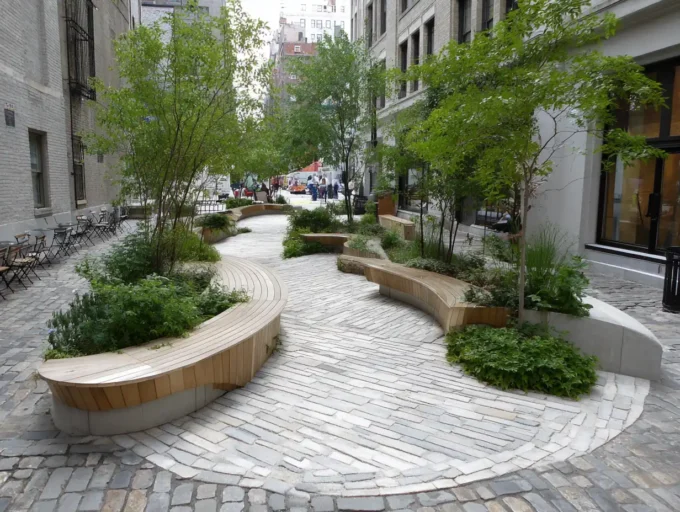As cities grow and evolve, the need for sustainable urban design has never been more critical. We’re witnessing a groundbreaking shift where artificial intelligence (AI) is reshaping how we plan and build our urban spaces. By merging technology with sustainability, we’re unlocking smarter, greener solutions to tackle challenges like climate change, resource management, and population growth.
AI-driven innovations are helping us design cities that are not only efficient but also harmonious with the environment. From optimizing energy use to enhancing public transportation systems, these trends are transforming urban living as we know it. Together, we’re paving the way for more sustainable, tech-driven cities that prioritize both people and the planet.

Understanding Sustainable Urban Design
Sustainable urban design focuses on creating resilient cities that balance environmental, social, and economic needs. It prioritizes reducing ecological impacts while supporting population growth and improving urban living standards. Key components include energy-efficient infrastructure, integrated public transportation, green spaces, and renewable energy adoption.
Urban layouts in sustainable design emphasize accessibility, minimizing vehicle dependency. Efficient zoning and mixed-use developments reduce travel distances and energy consumption. For example, combining residential, commercial, and recreational spaces fosters walkable communities and mitigates urban sprawl.
Natural resource management is central to sustainability in urban planning. Innovative drainage systems, water recycling facilities, and energy-sharing networks optimize resource use. Designing cities with renewable energy installations, like solar panels and wind turbines, further aligns with clean energy goals.
Public engagement is integral to successful sustainable design. Incorporating community needs and feedback ensures urban areas remain livable. Urban planners integrate AI-driven tools to analyze demographic data and model urban scenarios, tailoring solutions to specific populations.
Tech-enabled metrics guide the implementation of sustainable frameworks. AI monitors energy efficiency, tracks emissions, and predicts infrastructure needs. These insights enhance urban resilience, ensuring cities evolve sustainably under changing environmental conditions.
The Role Of AI In Urban Planning
AI is transforming urban planning by optimizing sustainability and efficiency. It integrates advanced analytics, automation, and machine learning to address urban challenges in real time.

How AI Enhances Sustainability
AI-driven algorithms enhance urban sustainability by analyzing real-time environmental data. Applications include the optimization of energy flows in smart grids, reduction of energy waste, and design of efficient building systems. For example, AI supports predictive maintenance in infrastructure, reducing resource consumption by identifying issues before failures occur.
AI also helps develop climate-resilient cities by modeling future climate scenarios and their impacts. These simulations guide adaptations like flood prevention systems or optimal tree planting for air quality improvement. Moreover, it aids in managing renewable energy integration and balancing power demand in urban areas.
Data-Driven Decision Making
AI enables urban planners to make informed decisions using data-rich models. By processing massive datasets, AI tools identify patterns in traffic, housing demands, and environmental factors. For example, deep learning algorithms predict traffic congestion, influencing smarter roadway designs or public transit expansions.
Additionally, demographic and socioeconomic data analysis fosters equitable resource distribution. We use AI to assess affordability gaps in housing or access to public amenities, enabling tailored interventions. These insights ensure urban designs align with sustainability goals and community-specific needs.
Key Trends In Sustainable Urban Design Driven By AI
AI continues to transform sustainable urban design by enabling smarter resource management, promoting eco-friendly infrastructure, and enhancing livability. Let’s explore key trends shaping this AI-driven shift toward sustainability.

Smart Cities And Energy Efficiency
Smart cities leverage AI to optimize energy use and minimize environmental impacts. AI-driven energy management systems analyze real-time data to improve distribution in smart grids, reducing energy waste and enhancing grid stability. For example, predictive algorithms allocate renewable energy resources, ensuring efficient power distribution across residential, commercial, and industrial zones. Automated building management systems utilize AI to regulate energy consumption in lighting, heating, and cooling, achieving consistent energy efficiency.
Green Infrastructure And Urban Landscapes
AI shapes urban landscapes by supporting the integration of green infrastructure. Intelligent systems identify optimal locations for green roofs, vertical gardens, and urban forests to enhance air quality, reduce heat islands, and manage stormwater. Machine learning models track vegetation health and suggest maintenance schedules, increasing the longevity of green spaces. For instance, AI-powered tools model the benefits of bioswales in drainage, improving flood resilience.
AI-Powered Traffic Optimization
AI optimizes urban mobility by streamlining traffic flow and reducing congestion. Real-time traffic monitoring systems use AI to analyze patterns, predicting and mitigating bottlenecks through adaptive signal control and dynamic route recommendations. These systems prioritize public transportation, bike lanes, and pedestrian pathways, aligning transportation networks with sustainability goals. Autonomous vehicle integration further minimizes emissions by using AI to manage fuel-efficient driving routes and reduce wait times in traffic.
Challenges And Ethical Considerations
Integrating AI into sustainable urban design brings challenges that demand careful attention. Addressing these issues ensures ethical implementation and long-term success.

Data Privacy Concerns
AI relies on vast amounts of data to optimize urban systems, which raises privacy concerns. Collecting real-time information on energy usage, transportation patterns, and public behaviors could expose sensitive personal data. Ensuring robust data anonymization techniques and implementing stringent cybersecurity measures is crucial to avoid breaches or misuse. Regulatory frameworks, like GDPR, guide responsible data handling, but urban planners must adopt compliance strategies that prioritize public trust.
Balancing Technology With Human-Centric Design
AI-driven solutions often prioritize efficiency but may overlook human needs. Focusing solely on optimizing systems risks creating spaces that feel impersonal or fail to foster community connections. For example, AI might recommend infrastructure designs that optimize traffic flows but compromise pedestrian accessibility. Our approach must balance technological innovation with principles of inclusivity, well-being, and social equity. Collaborating with communities during the decision-making process ensures that urban designs remain both high-tech and humane.
Future Outlook Of AI In Sustainable Urban Design
AI is expected to redefine urban design by driving scalability and personalization in sustainability strategies. As AI technologies advance, we anticipate more precise modeling tools that simulate urban ecosystems, enabling planners to optimize designs for energy efficiency, climate resilience, and resource usage. For example, virtual city simulations could test multiple scenarios to refine urban layouts, minimize waste, and enhance livability.
AI’s role in managing dynamic resources like energy and water is likely to expand with the growth of Internet of Things (IoT) networks. Smart sensors integrated with AI systems could monitor resource flows in real time while proposing adaptive strategies to maintain efficiency under changing conditions. Urban farming, renewable energy integration, and water recycling could benefit from these advancements.
AI-enabled mobility solutions are poised to reduce emissions further and improve transportation networks. Autonomous public transportation systems could complement AI-driven traffic management, reducing congestion and prioritizing sustainable travel options. Predictive algorithms may enhance route planning for last-mile logistics, ensuring minimal environmental impact.
Hyper-localized urban designs may emerge, as AI tools analyze granular data from neighborhoods to address specific social and environmental needs. These tools could personalize urban amenities like green spaces, transportation hubs, and energy systems to align with community preferences.
Developing ethical frameworks will remain critical as AI’s influence grows. We predict that transparent algorithms, equitable data access, and broader stakeholder engagement will define the future of AI-driven sustainable urban designs. Emphasis on inclusivity and accountability will ensure balanced innovation and meaningful societal impact.

Conclusion
Sustainable urban design trends driven by AI are transforming cities into more efficient, resilient, and environmentally friendly spaces. AI-powered tools optimize energy consumption, improve transportation systems, and enhance resource management in urban environments. By integrating technologies like predictive analytics and real-time monitoring, we can create adaptable infrastructures capable of addressing climate challenges and population demands.
As AI continues to shape urban development, ensuring ethical considerations remain central is vital for responsible innovation. Transparency, privacy, and equitable access to AI-driven solutions empower communities while fostering collaboration between stakeholders. These advances redefine how we achieve sustainability, aligning environmental priorities with the goals of livability and inclusivity in urban spaces.
- AI in city planning
- AI sustainability solutions
- AI-driven urban planning
- artificial intelligence in urban planning
- climate-responsive architecture
- Eco-friendly architecture
- energy-efficient urban design
- environmentally friendly city planning
- future of urban design
- green building design
- green city development
- innovation in urban design
- intelligent urban systems
- resilient city design
- smart city design trends
- smart city technology
- smart growth urban planning
- sustainable smart cities
- sustainable urban design
- urban green infrastructure
- urban sustainability solutions
















Leave a comment